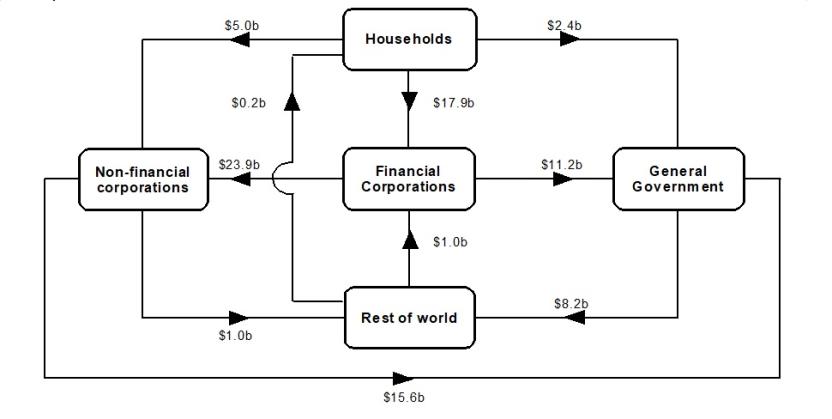National net lending (+) / borrowing (-), relative to GDP, seasonally adjusted
[["Dec-64","Mar-65","Jun-65","Sep-65","Dec-65","Mar-66","Jun-66","Sep-66","Dec-66","Mar-67","Jun-67","Sep-67","Dec-67","Mar-68","Jun-68","Sep-68","Dec-68","Mar-69","Jun-69","Sep-69","Dec-69","Mar-70","Jun-70","Sep-70","Dec-70","Mar-71","Jun-71","Sep-71","Dec-71","Mar-72","Jun-72","Sep-72","Dec-72","Mar-73","Jun-73","Sep-73","Dec-73","Mar-74","Jun-74","Sep-74","Dec-74","Mar-75","Jun-75","Sep-75","Dec-75","Mar-76","Jun-76","Sep-76","Dec-76","Mar-77","Jun-77","Sep-77","Dec-77","Mar-78","Jun-78","Sep-78","Dec-78","Mar-79","Jun-79","Sep-79","Dec-79","Mar-80","Jun-80","Sep-80","Dec-80","Mar-81","Jun-81","Sep-81","Dec-81","Mar-82","Jun-82","Sep-82","Dec-82","Mar-83","Jun-83","Sep-83","Dec-83","Mar-84","Jun-84","Sep-84","Dec-84","Mar-85","Jun-85","Sep-85","Dec-85","Mar-86","Jun-86","Sep-86","Dec-86","Mar-87","Jun-87","Sep-87","Dec-87","Mar-88","Jun-88","Sep-88","Dec-88","Mar-89","Jun-89","Sep-89","Dec-89","Mar-90","Jun-90","Sep-90","Dec-90","Mar-91","Jun-91","Sep-91","Dec-91","Mar-92","Jun-92","Sep-92","Dec-92","Mar-93","Jun-93","Sep-93","Dec-93","Mar-94","Jun-94","Sep-94","Dec-94","Mar-95","Jun-95","Sep-95","Dec-95","Mar-96","Jun-96","Sep-96","Dec-96","Mar-97","Jun-97","Sep-97","Dec-97","Mar-98","Jun-98","Sep-98","Dec-98","Mar-99","Jun-99","Sep-99","Dec-99","Mar-00","Jun-00","Sep-00","Dec-00","Mar-01","Jun-01","Sep-01","Dec-01","Mar-02","Jun-02","Sep-02","Dec-02","Mar-03","Jun-03","Sep-03","Dec-03","Mar-04","Jun-04","Sep-04","Dec-04","Mar-05","Jun-05","Sep-05","Dec-05","Mar-06","Jun-06","Sep-06","Dec-06","Mar-07","Jun-07","Sep-07","Dec-07","Mar-08","Jun-08","Sep-08","Dec-08","Mar-09","Jun-09","Sep-09","Dec-09","Mar-10","Jun-10","Sep-10","Dec-10","Mar-11","Jun-11","Sep-11","Dec-11","Mar-12","Jun-12","Sep-12","Dec-12","Mar-13","Jun-13","Sep-13","Dec-13","Mar-14","Jun-14","Sep-14","Dec-14","Mar-15","Jun-15","Sep-15","Dec-15","Mar-16","Jun-16","Sep-16","Dec-16","Mar-17","Jun-17","Sep-17","Dec-17","Mar-18","Jun-18","Sep-18","Dec-18","Mar-19","Jun-19","Sep-19","Dec-19","Mar-20","Jun-20","Sep-20","Dec-20","Mar-21","Jun-21","Sep-21","Dec-21"],[[-2.2999999999999998],[-3.2999999999999998],[-3.2999999999999998],[-4.4000000000000004],[-3.7000000000000002],[-2.7999999999999998],[-1.8],[-1.8999999999999999],[-1.8999999999999999],[-2.6000000000000001],[-1.8999999999999999],[-2.8999999999999999],[-2.8999999999999999],[-5.2000000000000002],[-3.2000000000000002],[-3.7000000000000002],[-2.3999999999999999],[-2.3999999999999999],[-2.2999999999999998],[-1.3999999999999999],[-1.7],[-1.3999999999999999],[-1.8999999999999999],[-1.5],[-1.7],[-2.1000000000000001],[-1.1000000000000001],[-0.90000000000000002],[-1.3999999999999999],[-0.20000000000000001],[1.1000000000000001],[1.6000000000000001],[2.2000000000000002],[2],[1.6000000000000001],[0.40000000000000002],[0.40000000000000002],[-1.8999999999999999],[-3.5],[-3.1000000000000001],[-2.5],[-0.40000000000000002],[0.10000000000000001],[-1.1000000000000001],[-1.8999999999999999],[-1.8],[-1.1000000000000001],[-1.2],[-1.8],[-3],[-2.8999999999999999],[-3.1000000000000001],[-1.2],[-2.8999999999999999],[-3.1000000000000001],[-3.7000000000000002],[-3.6000000000000001],[-2],[-2],[-1.8],[-0.80000000000000004],[-1],[-1.8],[-3.8999999999999999],[-3.2999999999999998],[-2.8999999999999999],[-4.2000000000000002],[-4.0999999999999996],[-5.4000000000000004],[-5.5],[-4.7999999999999998],[-3.5],[-3.3999999999999999],[-3.6000000000000001],[-3],[-3.7000000000000002],[-2.8999999999999999],[-4],[-3.5],[-4.5],[-5.2000000000000002],[-4.0999999999999996],[-4.5],[-5.5999999999999996],[-5.7000000000000002],[-6],[-5.5999999999999996],[-4.7999999999999998],[-4.4000000000000004],[-4.0999999999999996],[-3.2000000000000002],[-3.2999999999999998],[-3.2999999999999998],[-3],[-2.8999999999999999],[-3.8999999999999999],[-4.9000000000000004],[-5.5999999999999996],[-6],[-6.5],[-6.2999999999999998],[-6.2000000000000002],[-4.4000000000000004],[-4.2000000000000002],[-4.9000000000000004],[-3.8999999999999999],[-3.2999999999999998],[-3.1000000000000001],[-3],[-3],[-3.2999999999999998],[-3.7999999999999998],[-3.2000000000000002],[-3],[-3.2000000000000002],[-3.2999999999999998],[-3],[-2.8999999999999999],[-4.4000000000000004],[-5.5],[-5.4000000000000004],[-5.7999999999999998],[-5.0999999999999996],[-4.5],[-4.9000000000000004],[-4],[-2.7999999999999998],[-3.8999999999999999],[-3.3999999999999999],[-3.1000000000000001],[-2],[-3.1000000000000001],[-3.7000000000000002],[-5.0999999999999996],[-4.2000000000000002],[-5.5999999999999996],[-5],[-5.7000000000000002],[-6],[-5.7000000000000002],[-4.7999999999999998],[-4.9000000000000004],[-5],[-3.3999999999999999],[-3.5],[-2.5],[-2.2000000000000002],[-1.8],[-2.7999999999999998],[-2.7000000000000002],[-3.7000000000000002],[-3.8999999999999999],[-5],[-5],[-5.5999999999999996],[-5.4000000000000004],[-5.4000000000000004],[-5.7000000000000002],[-5.5999999999999996],[-6.5999999999999996],[-7.2999999999999998],[-6.5999999999999996],[-5.7000000000000002],[-6],[-5.7999999999999998],[-5.4000000000000004],[-6.2999999999999998],[-5.7999999999999998],[-6],[-6.0999999999999996],[-6.7000000000000002],[-6.9000000000000004],[-7.2999999999999998],[-6.7999999999999998],[-5.9000000000000004],[-4],[-2.8999999999999999],[-1.5],[-5],[-5.2999999999999998],[-6.4000000000000004],[-5.5],[-3],[-3.1000000000000001],[-3.2999999999999998],[-3.3999999999999999],[-3.1000000000000001],[-2.6000000000000001],[-3],[-4.7000000000000002],[-3.7000000000000002],[-4.4000000000000004],[-4.7000000000000002],[-3.6000000000000001],[-3.6000000000000001],[-3.7000000000000002],[-2.7999999999999998],[-2.7000000000000002],[-3.1000000000000001],[-3.3999999999999999],[-3.1000000000000001],[-3.3999999999999999],[-5.0999999999999996],[-4.7999999999999998],[-5.2999999999999998],[-4.2999999999999998],[-4.2999999999999998],[-3.2999999999999998],[-1.5],[-1.8999999999999999],[-2.5],[-2.6000000000000001],[-3.3999999999999999],[-2.6000000000000001],[-2.8999999999999999],[-2],[-1.1000000000000001],[-0.90000000000000002],[0.69999999999999996],[1.6000000000000001],[0.80000000000000004],[1.3],[3.5],[2.1000000000000001],[3.2999999999999998],[3.7000000000000002],[4.0999999999999996],[4],[2.2000000000000002]]]
[]
[{"axis_id":"0","tick_interval":"12","axis_min":"","axis_max":"","axis_title":"","precision":-1,"axis_units":"","tooltip_units":"","table_units":"","data_unit_prefix":"","data_unit_suffix":"","reverse_axis":false}][{"axis_id":"0","tick_interval":"","axis_min":"-10","axis_max":"5","axis_title":"%","precision":"1","table_units":"(%)","tooltip_units":"(%)","axis_units":"","data_unit_prefix":"","data_unit_suffix":"","reverse_axis":false}]
